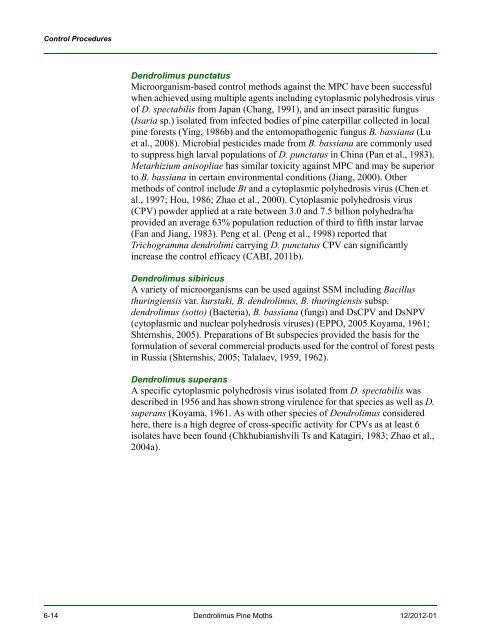New Pest Response Guidelines - aphis - US Department of Agriculture
New Pest Response Guidelines - aphis - US Department of Agriculture
New Pest Response Guidelines - aphis - US Department of Agriculture
You also want an ePaper? Increase the reach of your titles
YUMPU automatically turns print PDFs into web optimized ePapers that Google loves.
Control Procedures<br />
Dendrolimus punctatus<br />
Microorganism-based control methods against the MPC have been successful<br />
when achieved using multiple agents including cytoplasmic polyhedrosis virus<br />
<strong>of</strong> D. spectabilis from Japan (Chang, 1991), and an insect parasitic fungus<br />
(Isaria sp.) isolated from infected bodies <strong>of</strong> pine caterpillar collected in local<br />
pine forests (Ying, 1986b) and the entomopathogenic fungus B. bassiana (Lu<br />
et al., 2008). Microbial pesticides made from B. bassiana are commonly used<br />
to suppress high larval populations <strong>of</strong> D. punctatus in China (Pan et al., 1983).<br />
Metarhizium anisopliae has similar toxicity against MPC and may be superior<br />
to B. bassiana in certain environmental conditions (Jiang, 2000). Other<br />
methods <strong>of</strong> control include Bt and a cytoplasmic polyhedrosis virus (Chen et<br />
al., 1997; Hou, 1986; Zhao et al., 2000). Cytoplasmic polyhedrosis virus<br />
(CPV) powder applied at a rate between 3.0 and 7.5 billion polyhedra/ha<br />
provided an average 63% population reduction <strong>of</strong> third to fifth instar larvae<br />
(Fan and Jiang, 1983). Peng et al. (Peng et al., 1998) reported that<br />
Trichogramma dendrolimi carrying D. punctatus CPV can significantly<br />
increase the control efficacy (CABI, 2011b).<br />
Dendrolimus sibiricus<br />
A variety <strong>of</strong> microorganisms can be used against SSM including Bacillus<br />
thuringiensis var. kurstaki, B. dendrolimus, B. thuringiensis subsp.<br />
dendrolimus (sotto) (Bacteria), B. bassiana (fungi) and DsCPV and DsNPV<br />
(cytoplasmic and nuclear polyhedrosis viruses) (EPPO, 2005 Koyama, 1961;<br />
Shternshis, 2005). Preparations <strong>of</strong> Bt subspecies provided the basis for the<br />
formulation <strong>of</strong> several commercial products used for the control <strong>of</strong> forest pests<br />
in Russia (Shternshis, 2005; Talalaev, 1959, 1962).<br />
Dendrolimus superans<br />
A specific cytoplasmic polyhedrosis virus isolated from D. spectabilis was<br />
described in 1956 and has shown strong virulence for that species as well as D.<br />
superans (Koyama, 1961. As with other species <strong>of</strong> Dendrolimus considered<br />
here, there is a high degree <strong>of</strong> cross-specific activity for CPVs as at least 6<br />
isolates have been found (Chkhubianishvili Ts and Katagiri, 1983; Zhao et al.,<br />
2004a).<br />
6-14 Dendrolimus Pine Moths 12/2012-01

















